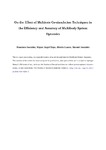Mostrar o rexistro simple do ítem
On the Effect of Multirate Co-simulation Techniques in the Efficiency and Accuracy of Multibody System Dynamics
| dc.contributor.author | González Varela, Francisco Javier | |
| dc.contributor.author | Naya, Miguel A. | |
| dc.contributor.author | González Castro, Manuel Jesús | |
| dc.contributor.author | Luaces, Alberto | |
| dc.date.accessioned | 2024-01-12T08:42:31Z | |
| dc.date.available | 2024-01-12T08:42:31Z | |
| dc.date.issued | 2010 | |
| dc.identifier.citation | González, F., Naya, M.Á., Luaces, A. et al. On the effect of multirate co-simulation techniques in the efficiency and accuracy of multibody system dynamics. Multibody Syst Dyn 25, 461–483 (2011). https://doi.org/10.1007/s11044-010-9234-7 | es_ES |
| dc.identifier.issn | 1573-272X | |
| dc.identifier.uri | http://hdl.handle.net/2183/34863 | |
| dc.description | This is a post-peer-review, pre-copyedit version of an article published in Multibody System Dynamics. This version of the article has been accepted for publication, after peer review and is subject to Springer Nature’s AM terms of use, but is not the Version of Record and does not reflect post-acceptance improvements, or any corrections. The Version of Record is available online at: http://dx.doi.org/10.1007/ s11044-010-9234-7. | es_ES |
| dc.description.abstract | [Abstract] Dynamic simulation of complex mechatronic systems can be carried out in an efficient and modular way making use of weakly coupled co-simulation setups. When using this approach, multirate methods are often needed to improve the efficiency, since the physical components of the system usually have different frequencies and time scales. However, most multirate methods have been designed for strongly coupled setups, and their application in weakly coupled cosimulation is not straightforward due to the limitations enforced by commercial simulation tools used in mechatronics design. This work describes a weakly coupled multirate method intended to be a generic multirate interface between block diagram software and multibody dynamics simulators, arranged in a co-simulation setup. Its main advantage is that it does not enforce equidistant or synchronized communication time-grids, and therefore it can be easily applied to set up weakly-coupled co-simulations using off-the-shelf commercial block diagram simulators while giving the user a great flexibility for selecting the integration scheme for each subsystem. The method is first tested on a simple, purely mechanical system with known analytical solution and variable frequency ratio (FR) of the coupled subsystems. Several synchronization schemes (fastest-first and slowest-first) and interpolation/extrapolation methods (polynomials of different orders and smoothing) have been implemented and tested. Next, the effect of the interface on accuracy and efficiency is assessed making use of a real-life co-simulation setting that links an MBS model of a kart to a thermal engine modelled in Simulink. Results show that the proposed weakly coupled multirate method can achieve considerable reductions in the execution times of the simulations without degrading the numerical solution of the problem | es_ES |
| dc.language.iso | eng | es_ES |
| dc.publisher | Springer | es_ES |
| dc.relation.uri | https://doi.org/10.1007/s11044-010-9234-7 | es_ES |
| dc.rights | Copyright © 2010, Springer Science Business Media B.V. | es_ES |
| dc.subject | Multibody | es_ES |
| dc.subject | Co-simulation | es_ES |
| dc.subject | Multirate | es_ES |
| dc.subject | Weak coupling | es_ES |
| dc.subject | Block diagram simulators | es_ES |
| dc.title | On the Effect of Multirate Co-simulation Techniques in the Efficiency and Accuracy of Multibody System Dynamics | es_ES |
| dc.type | info:eu-repo/semantics/article | es_ES |
| dc.rights.access | info:eu-repo/semantics/openAccess | es_ES |
| UDC.journalTitle | Multibody System Dynamics | es_ES |
| UDC.volume | 25 | es_ES |
| UDC.startPage | 461 | es_ES |
| UDC.endPage | 483 | es_ES |
Ficheiros no ítem
Este ítem aparece na(s) seguinte(s) colección(s)
-
LIM - Artigos [43]






